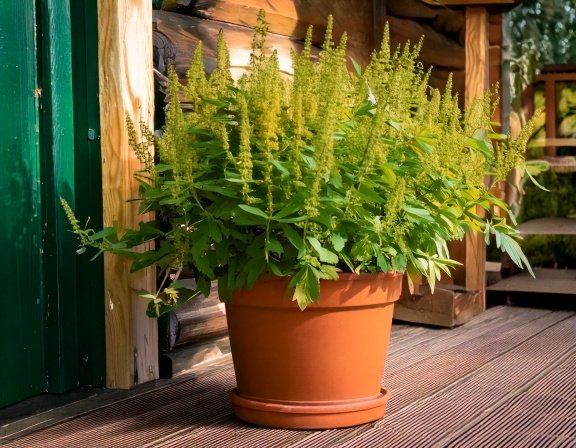Black Cohosh Root Benefits: Relief for Menopause & PMS – How to Grow & Use

Sugar, Mood and Hormones
The Sweet Truth About What Sugar Really Does to Women’s Bodies
Get Free Guide
Black cohosh (Actaea racemosa), a graceful woodland plant native to North America, has long been cherished for its ability to soothe menopause symptoms, balance PMS, and support women’s hormonal health naturally. In this post, you’ll discover the history, benefits, and science behind black cohosh, learn how to grow it in your garden, and get step-by-step advice for harvesting and using its potent roots at home.

How to Grow Black Cohosh for Women’s Wellness
Growing black cohosh (Actaea racemosa) at home allows you to cultivate a powerful ally for women’s hormonal and emotional wellness. This elegant woodland plant—with tall white flower spikes and deeply divided leaves—has been valued for centuries for its ability to support hormone balance, ease menopause symptoms, and calm the nervous system. Though it grows slowly, black cohosh is hardy and rewarding, thriving in shaded garden spaces where few other medicinal herbs flourish. With patience and care, you can nurture this sacred root for both beauty and wellness.
1. Choose the Right Location
Black cohosh is a shade-loving perennial that grows best in moist, rich soil similar to its native forest habitat. Select a cool, partially shaded area with dappled sunlight—such as under trees or along a north-facing fence. It prefers soil that retains moisture but drains well.
2. Prepare the Soil
Before planting, enrich the soil with plenty of organic compost, leaf mold, or aged manure. Black cohosh prefers slightly acidic soil (pH 5.5–6.5). Avoid overly sandy or compacted soil, as the roots need loose ground to expand and grow strong.
3. Planting from Roots or Seeds
You can start black cohosh from either root divisions or stratified seeds (seeds that have gone through a cold, moist period). Root divisions are the easiest and fastest way—plant them 2–3 inches deep and 18–24 inches apart in early spring or fall. If growing from seed, sow them in late fall so they can naturally stratify over winter.
Quietum Plus: Natural Support for Ear & Neural Health
- Helps reduce inflammation in the inner ear and neural pathways
- Encourages healthy circulation and nerve communication
- Supports relief from tinnitus, ear stress, and neural discomfort

4. Watering & Care
Keep the soil consistently moist, especially during the first growing season. Black cohosh prefers humidity and thrives with regular watering, though it doesn’t tolerate waterlogged soil. Mulch around the base with leaves or straw to retain moisture and protect roots during winter.
5. Growth & Maintenance
Black cohosh grows slowly and may take 2–3 years to reach full maturity. The plant produces tall flower spikes in early to midsummer, reaching 4–6 feet in height. Remove faded flower stalks after blooming to conserve root energy. The leaves will naturally die back in late autumn—leave them in place to enrich the soil or compost them for reuse.
6. Harvesting
For medicinal use, harvest roots in the fall of the third or fourth year when the plant has fully matured. Carefully dig up the roots, rinse gently, and dry them in a shaded, well-ventilated space for 7–10 days. Mature roots are thick, aromatic, and packed with the compounds that support hormone balance and emotional calm.
7. Companion Plants
Black cohosh grows beautifully alongside other woodland herbs like goldenseal, blue cohosh, and ferns. These plants share similar soil and moisture preferences, creating a balanced micro-ecosystem that supports soil health and biodiversity.
Quick Tip: Black cohosh rewards patience. Once established, it will return year after year—offering both a stunning floral display and roots that strengthen feminine wellness naturally from the ground up.
Sugar Defender: Stabilize Blood Sugar, Boost Vitality
- Helps support healthy glucose levels and curb sugar cravings
- Promotes sustained energy, mood stability, and metabolic balance
- May support women experiencing insulin resistance, fatigue, or sugar swings

How to Grow Black Cohosh
- Soil: Moist, rich, well-drained soil with plenty of organic matter for strong rhizome development.
- Light: Prefers partial to full shade—ideal for woodland or shaded garden areas.
- Watering: Keep soil consistently moist, especially during hot or dry periods to prevent stress.
- Planting: Set root divisions or nursery starts in spring or fall, spacing 2–3 feet apart to allow mature spread.
- Maintenance: Apply a thick mulch layer to retain moisture, enrich soil, and suppress weeds naturally.
- Quick Growing Tip: Black Cohosh requires patience—plants take 3–5 years to mature but reward you with tall, showy blooms and deeply healing roots.
Okinawa Flat Belly Tonic: Inspired by Japanese Longevity
Naturally support a healthy metabolism and energy—blend the power of Okinawan herbs into your daily ritual.
Explore the ingredients
How and When to Harvest Black Cohosh Roots
Harvesting black cohosh roots at the right time ensures the highest potency and safest use for women’s wellness remedies. The roots are the most valuable part of the plant, rich in triterpene glycosides (like actein and cimicifugoside) and phenolic compounds that support hormonal balance and calm the nervous system. Because black cohosh grows slowly, patience is key—allowing the plant to mature fully before harvesting ensures both strength and sustainability.
When to Harvest:
The best time to harvest black cohosh roots is in the late fall, after the leaves and flower stalks have died back and the plant’s energy has returned to the root system. This usually occurs in the plant’s third or fourth year of growth. Mature roots are thicker, darker, and more aromatic, indicating they’ve developed their full concentration of active compounds.
If you’re growing black cohosh in a shaded garden bed, wait until after the first light frost—when the top growth begins to yellow. This natural seasonal cue signals that the plant is storing its nutrients and medicinal strength in the roots, making it the ideal time to dig.
How to Harvest:
Use a garden fork or trowel to gently loosen the soil around the plant’s base, being careful not to damage nearby roots. Lift the root clump slowly, shaking off excess soil. The roots will appear thick and knobby, with small fibrous offshoots branching from the main rhizome. Rinse gently under cool water to remove dirt but avoid scrubbing too hard, as this can remove the outer layer where many compounds are concentrated.
For long-term use or replanting, divide the root mass—keeping a few healthy sections intact with buds or “eyes” attached—and replant them immediately. This ensures your black cohosh patch will continue to thrive and regenerate year after year.
Drying & Storage:
Slice large roots into smaller 2–3 inch sections to speed up drying. Spread them in a single layer on a drying screen or mesh rack in a shaded, well-ventilated area. Avoid direct sunlight, which can degrade the herb’s potency. Once the roots are completely dry and brittle, store them in airtight glass jars or brown paper bags in a cool, dark place. Properly dried black cohosh roots can maintain their quality for up to one year.
Sustainability Tip:
Wild black cohosh populations have declined due to overharvesting. Always cultivate your own or buy ethically grown, organically sourced roots to protect this sacred woodland species. When harvesting from your own garden, take only what you need and leave part of the root system to regrow.
Quick Tip: Mature black cohosh roots should be firm, aromatic, and earth-scented. The darker the interior color and richer the aroma, the more potent the medicinal compounds inside—perfect for making tinctures, teas, and hormone-supportive tonics.
Thyrafemme Balance: Adaptogenic Plant Blend for Women
- Features adaptogens: Ashwagandha, Rhodiola, Lemon Balm, Kelp/Iodine, Schisandra
- Plus selenium, zinc, L-tyrosine for full-spectrum hormone support
- No synthetic hormones—just time-tested botanicals and minerals
Black Cohosh for Menopause & PMS: Relief Rooted in Tradition & Science
Black Cohosh for Menopause & PMS: Relief Rooted in Tradition & Science
For centuries, black cohosh (Actaea racemosa) has been trusted as a natural ally for women navigating hormonal changes. From easing hot flashes and night sweats to soothing mood swings and tension, this powerful root bridges ancient wisdom and modern science. Its primary compounds—triterpene glycosides and isoflavones—help regulate hormonal activity and calm the nervous system without acting as synthetic hormones. Instead of replacing estrogen, black cohosh helps the body rebalance its own rhythms, offering comfort and stability through perimenopause, menopause, and PMS.
1. Easing Menopausal Symptoms
During menopause, fluctuating estrogen levels can trigger a cascade of symptoms—hot flashes, sleep disturbances, irritability, and fatigue. Black cohosh gently interacts with estrogen receptors and the hypothalamus, helping stabilize body temperature and mood regulation. Studies suggest that it may also influence serotonin activity, reducing both physical and emotional discomfort. Consistent use over several weeks can lead to noticeable improvements in overall comfort and balance.
2. Supporting PMS & Cycle Irregularities
For women in their reproductive years, black cohosh can help regulate menstrual cycles and reduce cramps or mood-related PMS symptoms. Its antispasmodic and nervine effects help relax uterine muscles while calming emotional tension—making it an ideal herb for easing the days leading up to menstruation. When combined with dong quai or red raspberry leaf, it provides even deeper support for hormonal harmony and menstrual ease.
3. Nervous System & Emotional Well-Being
Beyond hormonal balance, black cohosh nourishes the nervous system. Its gentle sedative properties promote relaxation, reduce stress, and improve sleep quality—especially when hormonal changes heighten anxiety or insomnia. It acts as both a physical and emotional stabilizer, grounding the body during transition phases.
4. Backed by Both Tradition & Research
Indigenous healers and early herbalists used black cohosh for women’s reproductive health long before modern medicine confirmed its benefits. Today, clinical research continues to explore its ability to relieve menopausal discomfort and improve mood balance, with promising results showing it as a safe, effective non-hormonal alternative for women who cannot or choose not to use hormone replacement therapy (HRT).
Quick Tip: Think of black cohosh as a balancer—it doesn’t override your hormones but helps them find their natural harmony again. Regular, mindful use can restore ease, emotional stability, and feminine vitality through every hormonal phase.
Black cohosh’s main compounds (triterpene glycosides and isoflavones) are believed to gently modulate hormones and support the nervous system.
How to Use:Once you’ve sourced quality black cohosh or harvested your own, there are a few simple ways to prepare it safely and effectively at home. Whether you prefer warm teas, soothing tinctures, or convenient daily capsules, black cohosh can easily be added to your wellness routine. Below are a few tried-and-true recipes and preparation methods to help you get the most from this balancing root.
How to Use Black Cohosh
Herbal Tea / Decoction: Simmer 1–2 tsp dried root in 2 cups of water for 20–30 minutes. Strain and drink 1–2 times daily to support hormonal and nervous balance.
Capsules & Tinctures: Follow product directions — typically 20–80 mg/day of standardized extract or 1–2 mL tincture in water once or twice daily.
Traditional Blends: Combine with red clover or raspberry leaf for added hormonal comfort and menstrual cycle support.
Safety Note: Generally safe for short-term use. Avoid if pregnant, nursing, or with liver conditions. Always consult a healthcare provider if taking medication or dealing with hormone-sensitive conditions.
Black Cohosh & Herbal Women’s Blend
Try a balanced herbal blend with black cohosh, raspberry leaf, and red clover for menopause and PMS support.
Shop Herbal Blend at AmazonNative American healers used black cohosh for centuries for “female complaints,” and early settlers nicknamed it “bugbane” for its insect-repelling flowers!
Ready to Support Hormonal Health, Naturally?
Subscribe to Health Intel Daily for more expert guides on menopause, PMS relief, and women’s herbal wisdom delivered right to your inbox!
Subscribe